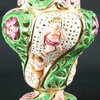
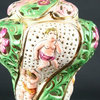
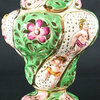
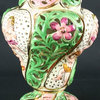
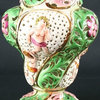
Item 1 of 5







Item 1 of 5


- Product Description
- Product Specifications
- Shipping and Returns
Product Details
- Item #: 5-386-0
- Dimensions (inches): 10.75H x 7.50W x 7.50D
- Comment: This charming Capodimonte-Style Reticulated Vase has pretty colors and a nice design.
- Origin: Italy
- Date: 1950
- Material: CERAMIC
- The word ceramic originates from the ancient Greek word keramikos, meaning potteres clay. The practice of making ceramics has been in existence for nearly 30,000 years. Clay, the primary ingredient for any ceramic, is primarily made of aluminum silicate, which is a malleable soil from crumbling rocks. Ceramics can be grouped according to the type of clay used, the temperature at which the clay is fired, and the duration of the firing.
- Availability: Available for Immediate Shipment.
- Condition
- Condition: GOOD
- In overall good condition. Antique and vintage items by their very nature show normal wear to finish and miscellaneous scratches, nicks, and dings due to age and use. As we define 'good condition' relative to the stated age of the piece, we would expect to see 'character marks' consistent with that age and could include nicks or dings to a wooden, metal, enamel, or chalkware object, wear to a painted surface, speckling on a mirror, crazing, wear to gilding, or manufacturing glaze skips in ceramic finish, wear to a label, and some original decorative trim may be missing. If ceramic/porcelain restoration has been done, it is of museum-quality so that it is hardly discernible and would be specifically mentioned in the listing. 'Good condition' could include very small fleabite chips or very small hairline cracks in any glass, ceramic, or marble item, but these would be specifically mentioned in the listing.
- Item Specifics: Shows wear to the gilding due to age and use.
- Shipping
- This Item Ships Free within the Contiguous 48 United States and this item will be shipped via a Ground shipping service (UPS or FedEx), approximate 1-6 business day shipping time. EuroLux may ship some packages via USPS Parcel Post, approximately 2-9 business day delivery time, at its sole discretion. All shipments include insurance.
Additional Information
- Mark: EuroLux Home
- Style: Capodimonte CAPODIMONTE (aka Capo Di Monte)
- The most famous porcelain manufacturer in Italy was Capodimonte, which was founded in 1736 at the Royal Court in Naples. Charles VII (1738 e 1759), son of Philip V of Spain, married Maria Amalia, granddaughter of Augustus II of Poland, founder of the Meissen porcelain factory in Germany. Charles VII wanted to create a porcelain factory in Italy that would rival that of Meissen. Without much initial success, he built a larger factory in 1743 in the Royal Wood of Capodimonte. Upon the death of Philip V, Charles moved to Spain to ascend the throne as Charles III of Spain and moved the entire production with him to Madrid, including all the molds and the skilled artists. Eventually Ferdinand IV King of Naples (1759 e 1816) returned the porcelain manufacture to Naples, where it continued as a royal factory until 1807. The high-quality works were in great demand throughout Europe. At that time, it was sold to a commercial corporation, which later closed in 1821. The business, including the original molds, was divided and sold in lots to several companies that still use the molds and the Capodimonte mark of a crown with a blue N today. Two of these companies are Doccia and Societe Richard Ceramica, also known as Ginori.
- Capodimonte was extremely influential in Italy and many Italian potters imitated their designs, especially those with flowers and mythological scenes. In modern usage today, Capodimonte denotes ceramics made in the general style and fashion of those made by the 18th century Neapolitan porcelain manufacturer, although most pieces today are not made of porcelain. A great many of these pieces were made in the 1950s and 1960s. Many of these Capodimonte style pieces are marked Bassano (a city focused on ceramic production in the Marche region) or simply Italy, or even without a mark at all.
- Object: Vase
Consigned Vintage Italian Capodimonte Style
Product Details
- Item #: 5-386-0
- Dimensions (inches): 10.75H x 7.50W x 7.50D
- Comment: This charming Capodimonte-Style Reticulated Vase has pretty colors and a nice design.
- Origin: Italy
- Date: 1950
- Material: CERAMIC
- The word ceramic originates from the ancient Greek word keramikos, meaning potteres clay. The practice of making ceramics has been in existence for nearly 30,000 years. Clay, the primary ingredient for any ceramic, is primarily made of aluminum silicate, which is a malleable soil from crumbling rocks. Ceramics can be grouped according to the type of clay used, the temperature at which the clay is fired, and the duration of the firing.
- Availability: Available for Immediate Shipment.
- Condition
- Condition: GOOD
- In overall good condition. Antique and vintage items by their very nature show normal wear to finish and miscellaneous scratches, nicks, and dings due to age and use. As we define 'good condition' relative to the stated age of the piece, we would expect to see 'character marks' consistent with that age and could include nicks or dings to a wooden, metal, enamel, or chalkware object, wear to a painted surface, speckling on a mirror, crazing, wear to gilding, or manufacturing glaze skips in ceramic finish, wear to a label, and some original decorative trim may be missing. If ceramic/porcelain restoration has been done, it is of museum-quality so that it is hardly discernible and would be specifically mentioned in the listing. 'Good condition' could include very small fleabite chips or very small hairline cracks in any glass, ceramic, or marble item, but these would be specifically mentioned in the listing.
- Item Specifics: Shows wear to the gilding due to age and use.
- Shipping
- This Item Ships Free within the Contiguous 48 United States and this item will be shipped via a Ground shipping service (UPS or FedEx), approximate 1-6 business day shipping time. EuroLux may ship some packages via USPS Parcel Post, approximately 2-9 business day delivery time, at its sole discretion. All shipments include insurance.
Additional Information
- Mark: EuroLux Home
- Style: Capodimonte CAPODIMONTE (aka Capo Di Monte)
- The most famous porcelain manufacturer in Italy was Capodimonte, which was founded in 1736 at the Royal Court in Naples. Charles VII (1738 e 1759), son of Philip V of Spain, married Maria Amalia, granddaughter of Augustus II of Poland, founder of the Meissen porcelain factory in Germany. Charles VII wanted to create a porcelain factory in Italy that would rival that of Meissen. Without much initial success, he built a larger factory in 1743 in the Royal Wood of Capodimonte. Upon the death of Philip V, Charles moved to Spain to ascend the throne as Charles III of Spain and moved the entire production with him to Madrid, including all the molds and the skilled artists. Eventually Ferdinand IV King of Naples (1759 e 1816) returned the porcelain manufacture to Naples, where it continued as a royal factory until 1807. The high-quality works were in great demand throughout Europe. At that time, it was sold to a commercial corporation, which later closed in 1821. The business, including the original molds, was divided and sold in lots to several companies that still use the molds and the Capodimonte mark of a crown with a blue N today. Two of these companies are Doccia and Societe Richard Ceramica, also known as Ginori.
- Capodimonte was extremely influential in Italy and many Italian potters imitated their designs, especially those with flowers and mythological scenes. In modern usage today, Capodimonte denotes ceramics made in the general style and fashion of those made by the 18th century Neapolitan porcelain manufacturer, although most pieces today are not made of porcelain. A great many of these pieces were made in the 1950s and 1960s. Many of these Capodimonte style pieces are marked Bassano (a city focused on ceramic production in the Marche region) or simply Italy, or even without a mark at all.
- Object: Vase
- Product ID
- 12654266
- Sold By
- hproduct
- Size
- W 7.5" / D 7.5" / H 10.75"
- Materials
- Ceramic
- Category
- Vases
- Style
- Traditional
- Product Description
- Product Specifications
- Shipping and Returns
Product Details
- Item #: 5-386-0
- Dimensions (inches): 10.75H x 7.50W x 7.50D
- Comment: This charming Capodimonte-Style Reticulated Vase has pretty colors and a nice design.
- Origin: Italy
- Date: 1950
- Material: CERAMIC
- The word ceramic originates from the ancient Greek word keramikos, meaning potteres clay. The practice of making ceramics has been in existence for nearly 30,000 years. Clay, the primary ingredient for any ceramic, is primarily made of aluminum silicate, which is a malleable soil from crumbling rocks. Ceramics can be grouped according to the type of clay used, the temperature at which the clay is fired, and the duration of the firing.
- Availability: Available for Immediate Shipment.
- Condition
- Condition: GOOD
- In overall good condition. Antique and vintage items by their very nature show normal wear to finish and miscellaneous scratches, nicks, and dings due to age and use. As we define 'good condition' relative to the stated age of the piece, we would expect to see 'character marks' consistent with that age and could include nicks or dings to a wooden, metal, enamel, or chalkware object, wear to a painted surface, speckling on a mirror, crazing, wear to gilding, or manufacturing glaze skips in ceramic finish, wear to a label, and some original decorative trim may be missing. If ceramic/porcelain restoration has been done, it is of museum-quality so that it is hardly discernible and would be specifically mentioned in the listing. 'Good condition' could include very small fleabite chips or very small hairline cracks in any glass, ceramic, or marble item, but these would be specifically mentioned in the listing.
- Item Specifics: Shows wear to the gilding due to age and use.
- Shipping
- This Item Ships Free within the Contiguous 48 United States and this item will be shipped via a Ground shipping service (UPS or FedEx), approximate 1-6 business day shipping time. EuroLux may ship some packages via USPS Parcel Post, approximately 2-9 business day delivery time, at its sole discretion. All shipments include insurance.
Additional Information
- Mark: EuroLux Home
- Style: Capodimonte CAPODIMONTE (aka Capo Di Monte)
- The most famous porcelain manufacturer in Italy was Capodimonte, which was founded in 1736 at the Royal Court in Naples. Charles VII (1738 e 1759), son of Philip V of Spain, married Maria Amalia, granddaughter of Augustus II of Poland, founder of the Meissen porcelain factory in Germany. Charles VII wanted to create a porcelain factory in Italy that would rival that of Meissen. Without much initial success, he built a larger factory in 1743 in the Royal Wood of Capodimonte. Upon the death of Philip V, Charles moved to Spain to ascend the throne as Charles III of Spain and moved the entire production with him to Madrid, including all the molds and the skilled artists. Eventually Ferdinand IV King of Naples (1759 e 1816) returned the porcelain manufacture to Naples, where it continued as a royal factory until 1807. The high-quality works were in great demand throughout Europe. At that time, it was sold to a commercial corporation, which later closed in 1821. The business, including the original molds, was divided and sold in lots to several companies that still use the molds and the Capodimonte mark of a crown with a blue N today. Two of these companies are Doccia and Societe Richard Ceramica, also known as Ginori.
- Capodimonte was extremely influential in Italy and many Italian potters imitated their designs, especially those with flowers and mythological scenes. In modern usage today, Capodimonte denotes ceramics made in the general style and fashion of those made by the 18th century Neapolitan porcelain manufacturer, although most pieces today are not made of porcelain. A great many of these pieces were made in the 1950s and 1960s. Many of these Capodimonte style pieces are marked Bassano (a city focused on ceramic production in the Marche region) or simply Italy, or even without a mark at all.
- Object: Vase
At Houzz we want you to shop for Consigned Vintage Italian Capodimonte Style with confidence. You can read real customer reviews for this or any other product and even ask questions and get answers from us or straight from the brand. When you buy Consigned Vintage Italian Capodimonte Style or any product product online from us, you become part of the Houzz family and can expect exceptional customer service every step of the way. If you have questions about or any other product for sale, our customer service team is eager to help.
Browse over 25 million home design photos on Houzz







